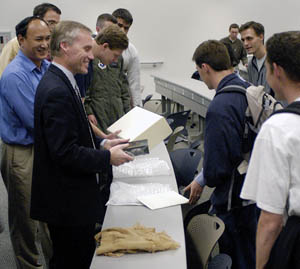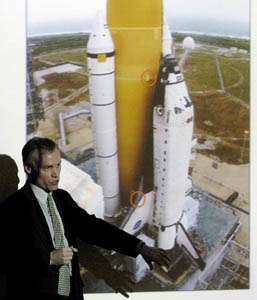Columbia investigator says foam was cause of explosion
The Utah State University chapter of the American Institute of Aeronautics and Astronautics (AIAA) brought one of the “Brilliant 10” scientist Monday for a lecture on campus.
James Walker, staff scientist of the Southwest Research Institute (SwRI) in San Antonio, Texas, was part of the Space Shuttle Columbia investigation team.
The Columbia orbiter was destroyed during re-entry on Feb. 1, 2003, killing seven astronauts. The SwRI was contracted as an independent verification source by NASA to research the cause of the accident, in addition to the two teams created inside the agency, according to Walker’s article “On the Leading Edge,” published by “Technology Today” in fall 2003.
Walker’s lecture explained how his research work went to students from the College of Engineering. According to the NASA Web site, he was responsible for writing the chapter titled “Impact Modeling” on the Volume II of the Report of the Columbia Accident Investigation Board.
Walker said his work was “a slice of a slice” of a large effort made by all the scientists involved with the investigation to find out the origin of the problem that led to the failure of the orbiter.
He explained how a piece of foam detached from the fuel tank and penetrated the leading edge of the shuttle’s left wing Jan. 16. The foam is responsible for keeping the cryogen cool and preventing the formation of ice on the fuel tank, Walker said.
The partial rupture of the shuttle’s fuel tank two weeks prior to the disintegration of the orbiter was the cause of the of the fatal accident, Walker said. The shuttle was launched and after reaching a speed of 1,568 miles per hour the piece of foam broke at an altitude of 65,900 feet, he said in his article.
The piece of foam traveled a distance of 58 feet in 0.16 seconds at 528 miles per hour, he said.
“The reason why the foam was slower than the shuttle is simple. If you are driving your car, say at 50 miles per hour, and throw something out the window, when your friend puts his hand out and catches it from the back window, the object will have a speed of, say 30 miles per hour,” Walker said.
Since the orbiter was destroyed, scientists had to use parts of other shuttles with similar designs, such as the Atlantis and the Enterprise, for their experiment, he said. The experiments conducted by the researchers tried to replicate the accident in order to understand what happened, Walker said during his lecture.
The SwRI works in a triangle system, the first stage is the experimentation; the second stage is the large numerical simulation in which equations and graphics are created with the results of the experiments and the third stage is the analysis of the previous stages, Walker said.
The Columbia shuttle was the first one to fly in 1981, and because of that, it was heavily instrumented, he said. After every flight – and Columbia had 28 – data was collected from the Modular Auxiliary Data System Recorder in the shuttle, Walker said. This data was recovered in March 2003 and also helped the scientists because it provided information about the maintenance of Columbia during the trip, Walker said.
The lecture was held in the Room 101 of the new Engineering Building with nearly 60 students in attendance. Walker answered students’ questions after his speech and also received a shirt from the College of Engineering and a plaque thanking him for his visit to USU. The participants and the speaker were invited to have refreshments at the new Engineering Building lobby.
Walker is a Salt Lake City native and graduated from the University of Utah when he was 18. After coming back from his LDS mission in Wisconsin, he received his Master’s Degree at age 22 and his Ph.D. at age 23, from the U of U. Walker said he has been working in the SwRI for the past 16 years and occasionally teaches a class at the University of Texas, in San Antonio.
The Southwest Research Institute is a non-profit research organization that works under contract. According to the SwRI Web site, SwRI has about 2,800 employees working in a 2 million square feet area and had more than $350 million in contracts in 2003.
-acantunes@cc.usu.edu

After his lecture, James Walker, a scientist from the Southwest Research Institute, shows students a piece of foam and tile from a space shuttle. These were the materials that his research studied to find the cause of the Columbia crash. (Photo by Ryan Talbot)

